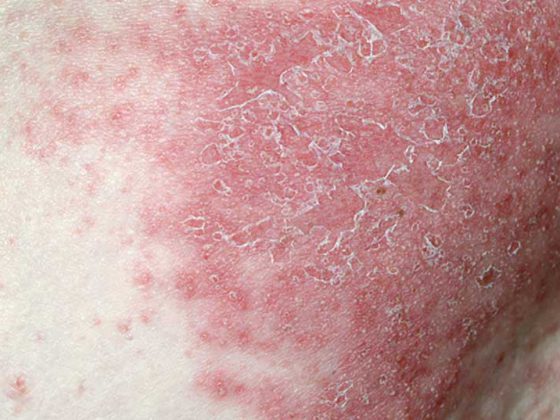About 14% of adolescents worldwide suffer from asthma symptoms. The disease thus represents a significant health burden for children. Exposure to adverse early risk factors may not only influence the development of asthma, but also contribute to lifelong impairment of lung function. A Melbourne research group has looked at these factors and recommends prevention strategies.
The International Study of Asthma and Allergies in Childhood (ISAAC) found that the burden of asthma was greatest in children aged 10-14 years, and it is the most common chronic condition in this age group, write Dr. Xin Dai, Allergy and Lung Health Unit, Centre for Epidemiology and Biostatistics, Melbourne School of Population and Global Health, University of Melbourne, and colleagues [1]. Although a large proportion of children with asthma/gasps go into remission early in life, some asthma persists into adulthood. Compared with physician-diagnosed late-onset asthma (after 3 years of age), children with early-onset asthma (up to and including 3 years of age) are more likely to have persistent respiratory symptoms into later childhood and even adulthood.
Increased risk for young children
Young children are more exposed than adults to many important household risk factors. They spend most of their time indoors and have an increased breathing rate, which means they breathe in more particulate matter relative to their body size. Also, they usually breathe closer to the ground, where the exposure in the air is higher.
Household air exposures containing allergens may increase the risk of atopic sensitization and lead to asthma through the development of airway inflammation, bronchial hyperresponsiveness, and reversible airway obstruction. Common household allergens include pet dander, mold and dust, and contact with these can trigger an allergic immune response in sensitive individuals. Exposures in early life can also modulate the immune system and increase the risk of asthma. The authors enumerate several household factors associated with an adverse influence on asthma pathogenesis and lung growth during early childhood and growing up:
Tobacco smoke
The link between smoking and lung disease is widely recognized, even by the tobacco industry. However, the effects of passive smoke exposure, particularly early life exposure, are still an active area of research. In utero exposure to maternal tobacco smoking is associated with increased rates of asthma and wheezing later in life. Nicotine has also been shown to have adverse effects on fetal lung development. However, the differential contributions of prenatal and postnatal smoking are unclear based on the available studies.
An Australian study observed 4276 children from birth to age 14. This study found that only smoking during pregnancy and smoking exposure after birth increased the risk of asthma symptoms at age 14. A cohort study in western Norway (n=3786) found that children exposed to only pre- or only postnatal tobacco smoke were not at significant risk of developing asthma and respiratory symptoms in adulthood. However, children exposed to maternal smoking during both periods were at significant risk for respiratory outcomes.
A cohort recorded smoking habits of women in early pregnancy and the smoking behavior and asthma of their children and grandchildren in follow-up. Maternal grandmothers’ smoking was associated with an increased risk of early persistent asthma in their grandchildren (aged 0-3 and 4-6 years) independent of maternal smoking. Another multigenerational analysis suggested that father smoking before conception increased the risk of parent-reported asthma for children at age 10 years. These results support a possible epigenetic transmission of risk through tobacco smoke exposure in previous generations.
Cooking/Heating
Solid fuel combustion, a major contributor to indoor air pollution in developing countries, also releases several gases, including nitrogen oxides, carbon monoxide, and carbon dioxide, all of which have been linked to lung damage.
Exposure to cooking/heating smoke occurs throughout life, including critical periods of lung development, and may even begin in the womb and continue throughout childhood and adulthood. Several cross-sectional and longitudinal studies have found that exposure to solid fuel smoke increases the risk of asthma and poor lung growth in children and young adults. However, the potential for serious effects of early life exposure, particularly during the critical period for lung growth, has not been adequately addressed. Currently, there is limited evidence that exposure to fuel smoke from cooking or heating in early life has adverse respiratory effects in later life.
Mold/Moisture
Several reviews have reported that mold and dampness are associated with a higher risk of asthma in children. Higher concentrations of fungal allergens, including Cladosporium spp, Alternaria spp, Aspergillus spp, and Penicillium spp, are found in homes with visible mold and evidence of dampness. These various allergens are very small (typically 2-10 µm), allowing easy penetration and deposition in the respiratory tract. They can bind antigen-specific immunoglobulin (Ig)E to mast cells or basophils, which are associated with hypersensitivity or allergic reactions. A meta-analysis of eight European birth cohorts reported a positive association between early exposure to visible mold and/or dampness during the first 2 years of life and the development of asthma in children aged 3 to 10 years.
However, few studies have followed up participants long enough to assess associations beyond childhood into adolescence. The current evidence does not provide enough data to draw a firm conclusion on adverse long-term associations, the authors said.
Dogs and cats
Given that households with cats and dogs have elevated concentrations of allergens in both dust and air samples, including Canis familiaris 1 and Felis domesticus 1, pets are thought to have an impact on asthma. In general, birth cohorts have not found that early life exposure to cats or dogs is associated with increased risk of childhood asthma or impaired lung function; however, early life exposure may have effects on respiratory health that are different from the effects of exposure at other times because it is an important window for respiratory system development.
This inconsistency may be due to reverse causality, in which people with asthma choose not to have pets, or recall bias in participants with current asthma. Determining pet ownership after the fact was more likely to lead to memory bias and a positive association between pet ownership and increased asthma risk, he said. Aside from the study design, there could also be problems with the way exposure is measured in cats and dogs. This is often done through questionnaires that do not directly measure the extent or type of allergen exposure.
In the long term, many studies show that early exposure protects against asthma. A Swedish birth cohort showed that owning a dog in the first year of life had an inverse association with late-onset wheezing at age 4; a population-based British study also found that owning a cat during pregnancy (at 28 weeks) was associated with a reduced risk of persistent wheezing in offspring at 6 months to 7 years of age. One hypothesis is that limited exposure to cat or dog allergens may induce immune tolerance and reduce the risk of developing elevated IgE to other allergens later in life. However, the exposure threshold that can lead to injury is unclear.
Detergent
In recent years, there is increasing evidence that contact with cleaning agents can cause respiratory irritation and chronic inflammation, which subsequently leads to asthma symptoms and reduced lung function. A recent study suggests that exposure that began around conception, pregnancy, and birth was associated with questionnaire-defined asthma for offspring at 10 years of age, but not exposure that began after birth, Such respiratory irritants may pose a risk to the respiratory development of the unborn baby through maternal transmission across the placenta. Studies addressing longer-term outcomes associated with exposure to cleaning agents after school age are needed to examine potential long-term associations.
Many scented cleaning products contain volatile organic compounds (VOCs). Some VOCs have been associated with asthma, atopic dermatitis, and allergies. Spray products such as air fresheners can be particularly hazardous because they facilitate aerosolized exposure.
Recommendations
Early-life exposures such as tobacco smoke, molds, and cleaning products are associated with long-term risks for asthma and lung dysfunction. For prevention, medical professionals might advise parents of infants and young children to remodel their homes to provide an “asthma-friendly” home environment when children exhibit wheezing or asthma symptoms. Asthma-friendly home environments are those that strive to keep indoor air as clean as possible.
The choice of home energy source is also associated with the risk of childhood asthma and lung function deficits. Burning gas and wood creates a complex mixture of carbon-based particles and gases that can have health effects on children. Electric technologies can reduce the release of particulates from household combustion activities. It is especially important to ventilate homes when using heating and cooking systems that can produce high levels of pollutants, such as gas cooking and solid fuel burning.
To avoid the risks associated with cleaning products, it may be important to reduce the frequency of their use and choose less harmful products. The American Lung Association recommends using cleaning products that “do not contain VOCs, fragrances, irritants or flammable ingredients.” Parents can avoid using cleaning products around children, provide adequate ventilation during and after cleaning activities, use dilute concentrations, avoid using multiple different products, and rinse surfaces with water after product use.
Literature:
- Dai X, Dharmage SC, Lodge CJ: The relationship of early-life household air pollution with childhood asthma and lung function. Eur Respir Rev 2022; 31: 220020; doi: 10.1183/16000617.0020-2022.
HAUSARZT PRAXIS 2023; 18(2): 28–30
InFo PNEUMOLOGIE & ALLERGOLOGIE 2023; 5(1): 38–40











